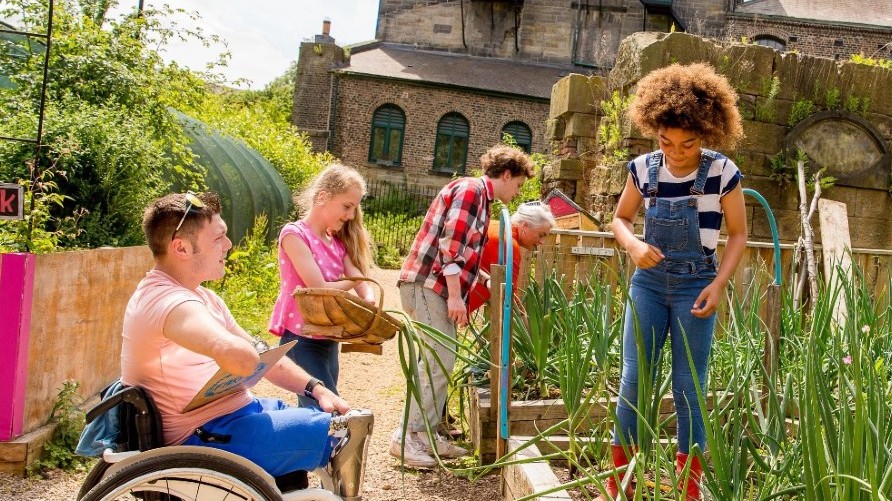Key points
- Social determinants of health (SDOH) are the nonmedical factors that influence health outcomes.
- SDOH are the conditions in which people are born, grow, work, live, and age that affect a wide range of health risks and outcomes.
- The National Center for Chronic Disease Prevention and Health Promotion (NCCDPHP) works to achieve health equity by addressing SDOH.

Overview
Social determinants of health (SDOH) are the nonmedical factors that influence health outcomes. They are the conditions in which people are born, grow, work, live, and age. These include a wide set of forces and systems that shape daily life such as economic policies and systems, development agendas, social norms, social policies, and political systems. CDC has adopted this definition from the World Health Organization.
Examples of negative SDOH
Examples of SDOH that can lead to poor health include:
- Poverty.
- Unsafe or unhealthy environments.
- Poor, unsafe, or unaffordable housing.
- Food insecurity, or lack of access to enough food for an active, healthy life.
- Lack of access to quality education and jobs that pay livable wages.
Driving factors behind these negative SDOH are economic policies and systems and social norms that have negatively affected the health of groups such as racial and ethnic minorities, people living in rural and urban areas, and people living with disabilities.
Another driving factor in racism. In 2021, CDC Director Rochelle Walensky declared racism to be a serious public health threat that directly affects the well-being of millions of people.
NCCDPHP’s approach
NCCDPHP aims to break down barriers to health equity by addressing SDOH in five areas that are strongly tied to chronic conditions:
Built Environment: Human-made surroundings that influence overall community health and people's behaviors that drive health.
People may be reluctant to walk or ride a bike in communities that have no sidewalks or unsafe street crossings. Adding crosswalks, bike lanes, and walking paths can encourage people to get more physical activity for recreation or transportation. Other examples of built environment include parks and recreational facilities as well as grocery stores and farmers’ markets. Read more about designing activity-friendly communities.
Community-Clinical Linkages: Connections made between health care, public health, and community organizations to improve population health.
When people are diagnosed with a chronic condition or told they are at risk, they don’t always have the support they need to take the next steps—for example, taking medicine as prescribed, quitting smoking, or losing weight. Community-clinical linkages can provide that support. For example, expanding the health care team to include a local pharmacist can help a patient with high blood pressure manage their condition. A doctor’s referral to a lifestyle change program can help a patient with prediabetes delay or avoid progression to type 2 diabetes.
Food and Nutrition Security: Having reliable access to enough high-quality food to avoid hunger and stay healthy.
In some communities, residents have few options for healthy foods that they can afford. Convenience stores may be the only place to buy groceries, especially in areas without good public transportation. Improving the food environment in communities, schools, and other places that sell or serve food can make it easier for people to eat well. Approaches include using incentives to help corner groceries stock and promote fresh produce and creating guidelines to help schools increase water access.
Social Connectedness: When people or groups have relationships that create a sense of belonging and being cared for, valued, and supported.
People with good social support are more likely to make healthy choices and better able to cope with stress, trauma, adversity, anxiety, and depression. For example, students who are supported at school have less suicidal ideation and less likelihood of experiencing violence. The What Works in Schools program funds efforts to ensure that schools are safe for the most vulnerable youth through anti-harassment policies, safe spaces, inclusive clubs, and professional development for school staff.
Tobacco-Free Policy: Population-based preventive measures to reduce tobacco use and tobacco-related illness and death.
Social factors like race, neighborhood, or employment can affect whether and how people are harmed by tobacco use or exposure to secondhand smoke. State and local policies can ensure that all groups are equally protected from the harms of tobacco—for example by limiting access to tobacco products, creating smokefree public spaces, and requiring health insurance coverage of quit-smoking treatments. Read more about tobacco disparities in specific groups and what can be done about them.
- World Health Organization. Social determinants of health. Accessed August 1, 2022. https://www.who.int/health-topics/social-determinants-of-health#tab=tab_1
- U.S. Department of Health and Human Services, Office of Disease Prevention and Health Promotion. Social determinants of health. Accessed August 24, 2022. https://health.gov/healthypeople/objectives-and-data/social-determinants-health
- Braveman P, Egerter S, Williams D. The social determinants of health: coming of age. Annu Rev Public Health. 2011;32:381–398. doi:10.1146/annurev-publhealth-031210-101218
- Braveman P, Gottlieb L. The social determinants of health: it's time to consider the causes of the causes. Public Health Rep. 2014;129 Suppl 2(Suppl 2):19–31. doi:10.1177/00333549141291S206
- Braveman P, Gruskin S. Defining equity in health. J Epidemiol Community Health. 2003;57(4):254–258. doi:10.1136/jech.57.4.254
